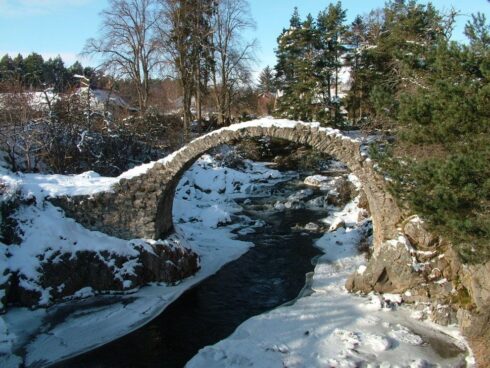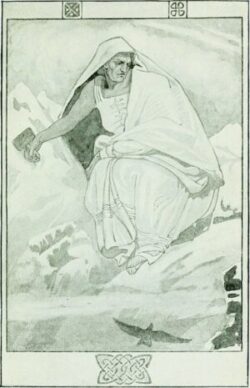Celtic Spirituality and the Old Crone.
Celtic Spirituality and the Transformed Maiden.
The Winter Goddess. Stories of Cailleach.

CELTIC SPIRITUALITY: Mother Maiden Crone – Goddess of Death, Rebirth & Change
Mother, Maiden and Old Woman. She was the One-Eyed Old Crone. A Crone who in Spring would transform into a beautiful Maiden. She was a complicated goddess.
She was of the Celtic people and the Celtic lands. And in Wintertime, the hard, rocky landscapes of Scotland, northern Britain, Wales, the Isle of Man and Ireland. She sometimes gave aid to those who respected the Natural Order. And she was vengeful with folk who sought to control the Balance of Nature.
If, like me, you’re hooked on Celtic Spirituality, then you’re on the right page.
Here’s a revealing Guest Blog from author Judi Singleton:
“Cailleach: The Goddess of Life and Death”
Cailleach, a figure steeped in Celtic Spirituality, embodies the duality of life and death. Winter and Spring. And Transformation. Known as the Veiled One, she is a symbol of the cyclical nature of existence.
She teaches us the importance of letting go to make way for new beginnings. This article delves into the rich lore surrounding Cailleach, her significance in various cultures, the lessons she imparts. And her essential place in Celtic Spirituality.
Celtic Spirituality: Who is Cailleach?
Cailleach, pronounced [COY-lck] or [CALL-y’ach], is a prominent figure in Celtic mythology, often depicted as an old woman or crone. The term “cailleach” translates to “old woman” or “veiled one” in Gaelic.
She is a weather goddess, controlling the winds and the harshness of winter. Despite her fearsome appearance (she is sometimes illustrated with the teeth of a wild bear and tusks like a boar), Cailleach is a symbol of transformation and renewal.
She is the goddess of weathered rock and mountains. Symbolized by ancient stone buildings. Even stony foot-bridges over water.
The Duality of Cailleach in Celtic Spirituality
Cailleach is often associated with the goddess Brighid. According to legend, on the Eve of Latha Fheill Bride, Cailleach drinks from the Well of Youth. Thus transforming into the youthful Brighid, heralding the arrival of spring. This transformation underscores the cyclical nature of life and the inevitability of change.
Celtic Spirituality: Cailleach in Scottish Folklore, aka the Hag of Beara
Beara is a rocky peninsula extending from the Cork and Kerry Mountains of Ireland.
 In Scottish folklore, Cailleach Beara is born old and grows younger as the year progresses from winter to spring and summer. This transformation is symbolic of the natural cycle of death and rebirth.
In Scottish folklore, Cailleach Beara is born old and grows younger as the year progresses from winter to spring and summer. This transformation is symbolic of the natural cycle of death and rebirth.
As the Winter Goddess, Cailleach Beara is responsible for the death of what is no longer needed. Making way for new growth.
In Scotland, she has also been called Beira, Queen of Winter. In Britain she was often referred to as Black Annis. And in more localised areas she was known as the Blue Hag of Winter, Woman of Stones, Bone Mother, Old Wife of Alban Arthan (the holiday also known as Yule), the Winter Goddess and the Old Woman of the Mountains.
Later, as Celtic Sprituality transformed into modern Celtic Christianity, the goddess was also called The White Nun of Beara.
Celtic Spirituality: Lessons from the Winter Goddess
Cailleach teaches us the importance of letting go. In life, we often hold onto things that no longer serve us, whether they’re habits, relationships, or possessions. By letting go, we create space for new opportunities and growth.
This lesson is particularly relevant in Times of Change. These are days of personal transformation. These are days when the Earth herself is changing — or being changed.
The Role of the Transformative Goddess in Celtic Culture
Every culture has a dark goddess who helps the transition from one state of being to another. In Celtic Spirituality, Cailleach fulfills this role. She is a reminder that change often requires letting go of the old to make room for the new.
The Symbolism of the Crone Goddess of Death, Rebirth & Transformation in Celtic Spirituality
Cailleach’s symbolism extends beyond her role as a weather goddess. She represents the darker aspects of life, such as death and decay. But also the potential for renewal and growth. Her one eye is said to see beyond duality, perceiving the oneness of life.
Three Interesting Facts About Cailleach
- Cailleach’s Transformation: In some stories, she washes in a stream just before spring and becomes young again, symbolizing the renewal of life.
- Cailleach and Brighid: The legend of Cailleach transforming into Brighid highlights the interconnectedness of life and death, winter and spring.
- Cailleach’s Role in Agriculture: In some traditions, she is also associated with the fertility of the land, holding the seeds of new beginnings in the frozen earth.
Celtic Spirituality Conclusion
Cailleach, the goddess of life and death, teaches us the importance of transformation and renewal. By letting go of what no longer serves us, we make room for new growth and opportunities. Her story is a powerful reminder of the cyclical nature of life and the inevitability of change.
By understanding the lore and lessons of Cailleach within the greater Celtic Spirituality, we can better appreciate the natural cycles of life and the importance of transformation.
Seven Recommended References About Cailleach:
- A CELTIC MISCELLANY: Translations from the Celtic Literatures, edited and translated by Kenneth Hurlstone Jackson; Routledge & Kegan Paul edition (1951), Revised edition Penguin (1971)
- DICTIONARY OF CELTIC MYTHOLOGY by Peter Berresford Ellis; Oxford University Press (1992)
- CAILLEACH: The Hag of Beara by Leanne O’Sullivan; Bloodaxe Books, Illustrated edition (2009)
- VISIONS OF THE CAILLEACH: Exploring the Myths, Folklore and Legends of the pre-eminent Celtic Hag Goddess, by Sorita D’Este and David Rankine; Avanlonia (2009)
- “In Gaelic (Irish, Scottish and Manx) myth, the Cailleach is a divine hag and ancestor, associated with the creation of the landscape and with the weather…” en.wikipedia.org/wiki/Cailleach.
- “The Cailleach was the goddess of the cold and the winds. Sometimes known as the Veiled One or the Queen of Winter, the Cailleach determined the winter’s length…” mythopedia.com/topics/cailleach.
- “The Cailleach is the goddess of the winter months and is said to control the weather and the winds as well as the length and harshness of winter.” irishcentral.com/cailleach-irish-goddess-winter-trail-ireland.
Thanks, Judi, for this inspiring article of Celtic Spirituality and the Old Crone. – Brian
For more, see my popular post Native American Legend: Wild Woman of the Woods – Woman of the Mask
And See My Most Popular (and Personal) Spiritual Post: ORNITHANTHROPUS — the Winged Human in Dream, Myth, Religion & Literature.
CELTIC SPIRITUALITY: Mother Maiden Crone – Goddess of Death, Rebirth & Change
Judi Singleton is a writer of well-crafted, well-researched articles. Her work can be found on ArticlesFactory. Among her articles are “The Earth Mother: Humanity’s First Deity.” “The Goddess Ala: Earth Mother of the Ibo Tribe.” And “Sheela-na-gig: The Enigmatic Celtic Goddess.” Source: Free Guest Posting Articles from ArticlesFactory.com.
Celtic Knots and Meanings, Celtic mythology creatures, Celtic Spirituality, Crone Goddess, Goddess of Death, old crone, the crone, what is Celtic?












